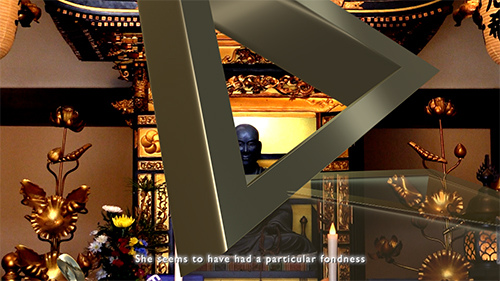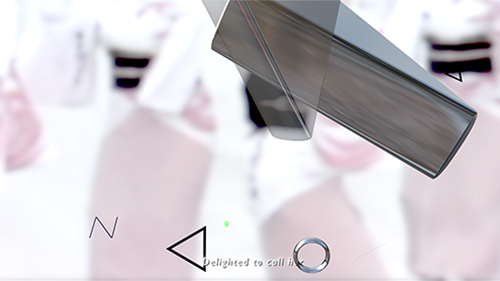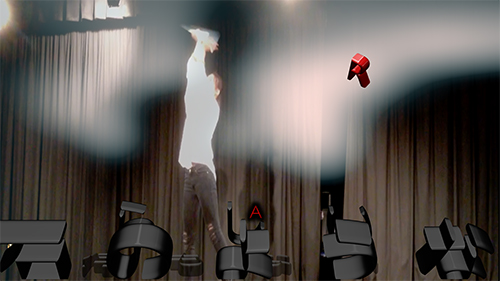MODERN DANCE . A metaphor for the paradoxes and excesses of contemporary indulgence., Should society be open to ideas on the basis of their true merit, creating a fluid situation that leads to the betterment of all classes? Or should the body polity be unified in thought and action behind one ethnic, religious or ideological idea, an idea that presumably makes the nation “stronger” and more successful at engaging in conflicts with other countries? ALL VIDEO AND MUSIC BY CHRISTOPHER LAWRIE. PLEASE USE HEADPHONES
These Artworks consist of juxtaposed elements of visual, audio and text. They are not necessarily intended to be illustrative of each other.
M D VIDEO ART/MUSIC Takuboku Ishikawa
.
MDO 131. SHIKI 1 HOTOGISU
At the age of 20, he spat up blood and the next year he coughed up much more. It was tuberculosis. After that he used the pen name 'Shiki'. 'Shiki' can also be read as 'Hototogisu' (Lesser Cuckoo). He chose the name because when the hototogisu opens its beak to sing, the red of its throat looks like blood. The pen name 'Shiki' also comes from a character in his given name Tsunenori.
When I drink. I cry in my dreams. Wild Cherry Blossoms.
Shiki 1 Hotogisu PDF

MDO 134. ISHIKAWA 1 THE CLIFF
Celebrated tanka poet rode the tumult of his times as he transformed from provincial romantic to national firebrand. The society of Takuboku Ishikawa’s era was in dramatic political flux, and its complex issues became his personal obsessions. After his death, Takuboku’s preoccupations came to be seen as a symbol of the social and emotional upheavals of his times. The key word in the last two decades of the Meiji Era (1868-1912) was “polemics.” Intellectuals and socially conscious people were actively involved in a nationwide discourse, played out in all aspects of the culture — literature, theater, graphic arts, journalism — as to what the nature of future Japanese society should be. In essence it is the same current that continues to rage today: Should society be open to ideas on the basis of their true merit, creating a fluid situation that leads to the betterment of all classes? Or should the body polity be unified in thought and action behind one ethnic, religious or ideological idea, an idea that presumably makes the nation “stronger” and more successful at engaging in conflicts with other countries?
The Cliff PDF

MDO 135. ISHIKAWA 2 REVOLUTION
It is clear that Takuboku identified in his writing with those people who fervently wanted to liberalize Japanese society, and this at a time when the nation was on a mission to create an empire in its expanding hemisphere of influence. Takuboku wrote about the downtrodden because he saw himself as one of them. Life for him, with a wife, daughter and mother to support, was a struggle for bare survival. The lack of job security that plagued Takuboku’s life, the necessity to move from place to place wherever there was work to be had, the anxiety caused by the fact that a person could be shunned for arguing against injustice, the introduction of restrictions on freedoms, the burgeoning oppression of people seen by the government as “radical” — these aspects of Takuboku’s times have once again become all too familiar in today’s Japan. This is reason enough to consider him our contemporary.
Revolution PDF

MDO 138. MURASAKI 1 Murasaki refers to both the heroine of the Genji Monogatari (The Tale of Genji), and the book's author. The 'Tale of the Genji' written in the 11th century CE by Murasaki Shikibu, a court lady, is Japan's oldest novel and possibly the first novel in world literature. Genji first discovers Murasaki, the leading heroine of the story, when she is a child of 10 and takes her home to raise. Some years later, he makes her his concubine.
It is sometimes used as a justification for the Japanese tendancy towards Rorikon. The sexual attraction to young girls.
Murasaki is the Japanese word for the color purple
Murasaki 1. PDF.
MDO 139. SHUSUI KOTOKU
An incident that influenced Takuboku greatly, was that involving the socialist author, translator and journalist Shusui Kotoku, who was arrested for treason on trumped-up charges and executed with others on Jan. 24, 1911. This date has to be seen as marking the beginning of the decline of Japanese democracy, a decline that took the country down the dark spiral staircase to the dungeon of defeat on Aug. 15, 1945.
Shusui Kotoku PDF.

MDO 157. KOYAKKO 4 He fell hopelessly in love with a number of women. He smiled when he drank, and women liked him. He easily succumbed to the effects of sake, for when someone pressed him to drink, he did not know how to decline with tact. On such occasions Koyakko often saved him by downing the sake herself. As she was a rather spirited girl, she acted as if she was actually in love with Takubboku when she was teased about her kindness to him. Accordingly, a rumour that they were attached to one another provoked the the couple into an even greater intimacy. She came to visit him at his lodgings, and they walked together along the sandy beach at Kushiro. Introduction to 'Romaji Diary and Sad Toys' by Ishikawa.
Koyakko 4. PDF.

MDO 137.ISHIKAWA 3 LIFE
Pachinko, like all gambling, is rigged. The house always wins. It's a central metaphor of life. It's rigged, but you keep playing. Min Jin Lee
Celebrated tanka poet rode the tumult of his times as he transformed from provincial romantic to national firebrand. The society of Takuboku Ishikawa’s era was in dramatic political flux, and its complex issues became his personal obsessions. After his death, Takuboku’s preoccupations came to be seen as a symbol of the social and emotional upheavals of his times. The key word in the last two decades of the Meiji Era (1868-1912) was “polemics.” Intellectuals and socially conscious people were actively involved in a nationwide discourse, played out in all aspects of the culture — literature, theater, graphic arts, journalism — as to what the nature of future Japanese society should be. In essence it is the same current that continues to rage today: Should society be open to ideas on the basis of their true merit, creating a fluid situation that leads to the betterment of all classes? Or should the body polity be unified in thought and action behind one ethnic, religious or ideological idea, an idea that presumably makes the nation “stronger” and more successful at engaging in conflicts with other countries? Life 1. PDF. Life 2. PDF

MDO 152.GOLD FOR BUDDHA The former guji (head priest) of Tokyo’s famous Tomioka Hachimangu Shrine allegedly murdered his sister before committing suicide. The suspect, Shigenaga Tomioka, had taken over the position from his father in 1995, but the father disapproved of his son’s spendthrift habits and, after temporarily reassuming the head priest position, willed it to his daughter, Nagako in 2010. Nagako herself reverted to the kind of extravagant lifestyle her brother enjoyed and which angered their father. She seems to have had a particular fondness for expensive host clubs. Meiji Shrine in Tokyo, the most popular shrine in Japan, takes in about ¥1.3 billion. Naritasan Shinshoji, a temple in Chiba Prefecture, comes in second with about ¥1.24 billion. Shrine murder highlights huge amount of cash — most of it off-book — raked in by Japan's religious sites.

MDO 151.100 YEARS I was reminded of the 1901 petition to the emperor when Diet member Yamamoto Taro handed an anti-nuclear letter to the emperor in 2013, exactly a century after the death of Tanaka Shozo; and I was dismayed at the vilification poured on Yamamoto by the media. Not much has changed in a century. Perhaps in some ways Meiji Japan was even more tolerant of dissent than today's Japan.
100 Years PDF.
100 Years Text PDF.

MDO 143. PARADOX 1 The World Value Survey in 2008 rated Japan as the most ‘secular-rational’ country in the world, exceeding even the famously atheistic countries of Sweden and the Czech Republic. This claim was based in part on a study conducted in Japan in 2005, in which 80.5% of those who responded said that religion (shukyo) was either ‘Not very important’ or ‘Not at all important’ in their lives (Yamazaki, 2005). But only one year earlier, in 2004, according to the U.S. Department of State’s International Religious Freedom Report, 213,826,661 Japanese citizens claimed they had a religion – a number that, as the report’s author notes, is nearly twice as large as Japan’s population. This statistic is roughly supported by the Japanese government’s yearly surveys, which show that the total number of religious adherents exceed the population of Japan. Because each person belongs to an average of two religions.
Paradox 1a PDF | Paradox 1b PDF | Paradox 1c Text PDF

MDO 153.SETSUKO After his death, Setsuko took Kyoko to Awa in Chiba Prefecture, where she gave birth to another daughter, Fusae. In September of that year, she returned to her family home in Hakodate with the two girls. In March 1913, Takuboku’s ashes were brought to Hakodate and interred there. Setsuko died of tuberculosis in May of that year, age 28. The daughters succumbed to illness in December 1930, Kyoko to pneumonia at age 23 and Fusae to tuberculosis at 18, both dying at a younger age than their parents were when they passed away.
Setsuko PDF.

MDO 154. KOYAKKO 1 STAB Takuboku had begun writing diaries in 1902, the most famous of them being his “Romaji Nikki” (“Diary in Roman Letters”), which he wrote in that script as an obstacle to his wife’s reading it. In fact, his tanka taken together also loosely form a kind of diary of events, internal and external. Takuboku wrote that poetry itself was a report in detail of changes in an individual’s emotions. His diaries and his poetry are permeated with a sincere and searching self-examination. They are deep stabs at truth.
My wife came with our daughter on her back.
I caught sight of her eyebrows
Through a blanket of snow
Stab PDF.

MDO 140. PAKIRUI Anime studio Kyoto Animation, the company behind numerous hits such as The Melancholy of Haruhi Suzumiya, Lucky Star, Clanaad, K-On!!, and Free!, has a production facility, designated Studio 1, in Kyoto’s Fushimi Ward, near Rokujizo Station. On the morning of July 18, 2019 at around 10:30, a man walked into Studio 1 and began pouring a liquid, believed to be gasoline, around the facility. Witnesses report that the man shouted “Die!” while doing this, and then set the liquid ablaze, causing a fire and a loud explosion. After lighting the fire, the arsonist, a 41-year-old man ran from the scene, but was taken into custody by police. Witnesses say that when asked by police at the scene why he had set the fire, the man said “They did pakirui.” Pakuri is the Japanese word for copying another’s art or creative work. 33 people died.

MDO 134. THE SIX FOOT SICKBED The Six-Foot Sickbed first appeared on May 5 1902. Although Shiki had rejected the vernacular genbun itchi style, opting to write prose in the older literary style, in this collection he wrote in the vernacular, making it more accessible than his other prose works. Some of Shiki’s greatest pleasures in his sickbed were painting and calligraphy, and his shasei sketches are an important legacy of those final years. Shiki was financially challenged during most of his adult years, and the money that he made from his writing was insufficient to hire either a full-time maid or nurse. The task of caring for Shiki fell on the shoulders of his mother and sister.
My life
How much of it remains
The night is brief

MDO 146. PARADOX 2 According to the CIA fact book of 2005, the breakdown of Japanese religious demographics was as follows: Shintoism 83.9%, Buddhism 71.4%, Christianity 2%, other 7.8%. That this exceeds 100% is further evidence that Japanese citizens belong to more than one religion. Taken together, these statistics describe a ‘secular-rational’ Japanese population in which very few people believe that religion is important and yet each person belongs to an average of two religions.
The Paradoxes of Secularism in Contemporary Japan.

MDO 138. FIVE YEAR OLD CHILD In 1907, Takuboku traveled alone to Hakodate in Hokkaido, becoming a substitute teacher at a primary school. However, the school burned down in a fire and he went to Sapporo, where, in August, he found work as a proofreader at a newspaper. By September he was in Otaru, this time writing for a daily, the Otaru Nippo. Alas, a violent altercation with an editor in December brought an abrupt end to that employment.
Like a stone. That rolls down a hill. I have come to this day.

MDO 45. HAKODATE 1907 Five year old child, I don’t know why Giving her a Russian name, Sonya Delighted to call her This poem is from Takuboku’s second collection of poems, Kanashiki Gangu (Sad Toys). “Five year old child” refers to Takuboku’s eldest daughter, Kyoto, who was born in 1906. When Takuboku wrote this poem, he was living in a boarding house in Tokyo, suffering from tuberculosis. The problem in interpretation is the Russian name, Sonya. The name has generally been thought of as an allusion to the Sonya of Dostoevsky’s Crime and Punishment. However I believe that the name Sonya refers to the Russian revolutionist, Sophie Perovskaya (1854-1881), whom he read about in Memoirs of a Revolusionist. by Peter Kropotkin.
Hakodate 1907 PDF

MDO 142. TYPHOON Powerful Typhoon Krosa is nearing Japan and is set to make landfall in the west of the country, the weather agency said Tuesday. The Meteorological Agency said the season’s 10th named storm was in the Pacific around 420 kilometers from the southwestern island of Tanegashima as of 9 p.m. Tuesday, and is expected to travel slowly through western regions on Wednesday and Thursday. Rain is forecast in the Tokai region, and the Kinki, Shikoku and Kyushu regions are expected to see about 200 mm. The approach of the typhoon will coincide with a rush of vacationers returning from summer holidays. Japan Airlines Co. and All Nippon Airways Co. said they will cancel a total of around 100 flights Wednesday to and from Miyazaki and other prefectures in Kyushu, which will affect more than 8,000 people.
The organizer of the famed Awa Odori festival in Tokushima Prefecture said it will cancel Wednesday’s performance due to the typhoon, the first such cancellation since 1996.
Takamatsu City Museum of Art Typhoon PDF

MDO 144. KROPOTKIN Ishikawa Takuboku and the Early Russian Revolutionary Movement Yukinori Iwaki
Takuboku borrowed the first edition of 'Memoirs of a Revolutionist' which was published in two volumes, from Toki Aika. The first volume covers Kropotkin’s early life, from his childhood as the son of a duke until his desertion from the military. The second volume describes his stormy life after he joined the revolutionary movement: his arrest, imprisonment, escape, and flight to England. Takaboku wrote down his impression of the book in the May 12, 1911 entry in his diary, “I felt uneasy in my chest and stayed in bed all day today. However I read Kropotkin’s autobiography from when he was arrested until he fled to England. Oddly, many reflections came to mind.”



